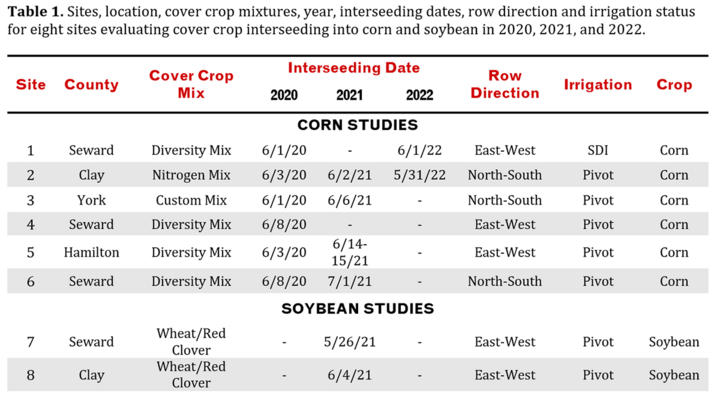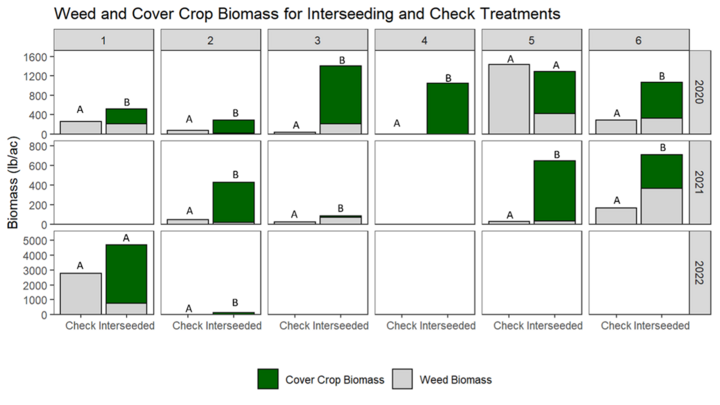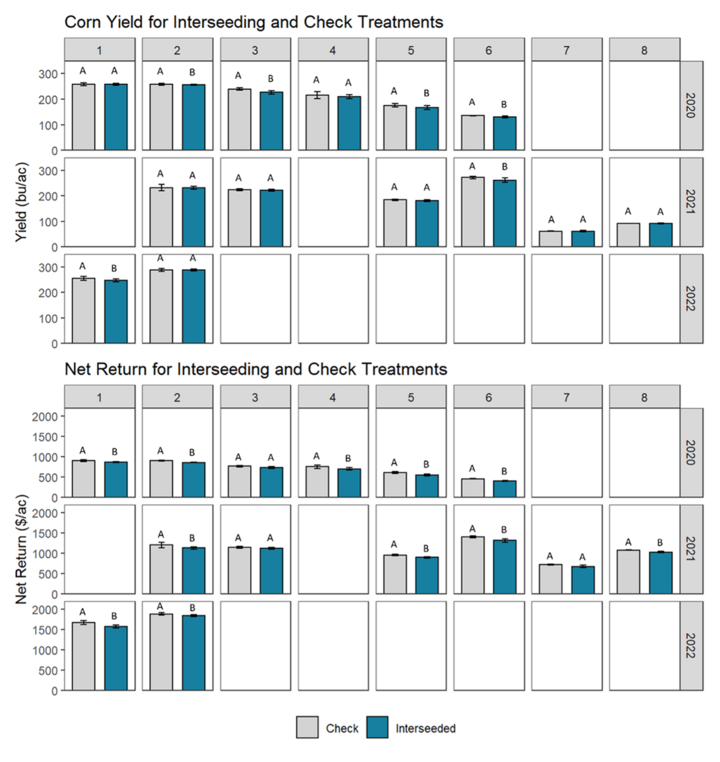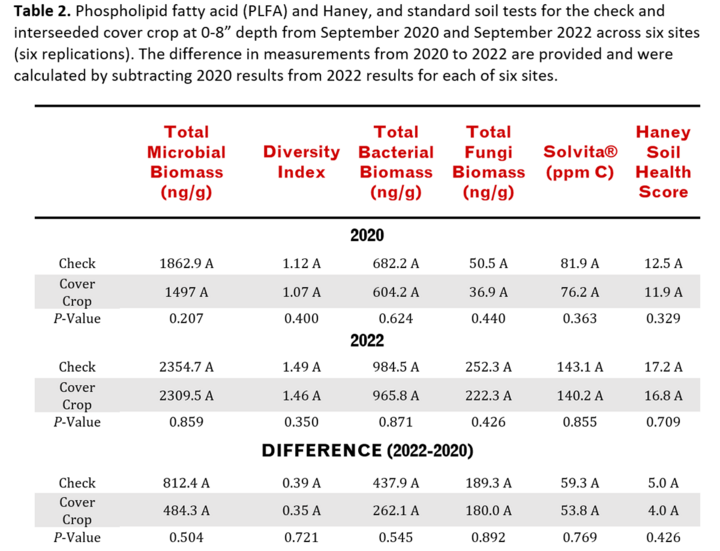
Interseeding cover crops is the process of seeding cover crops into a growing cash crop. The goals can include weed control, removing excess nitrogen, providing additional nitrogen, providing diversity, and establishing forage production prior to harvest.
Beyond drilling cereal rye and/or hairy vetch after corn harvest, few options exist for successfully establishing cover crops after a corn crop. Over the past five years, there’s been increased interest regarding drill or broadcast interseeding of cover crops into corn and soybean early in the growing season. Two Nebraska on-farm research studies in 2019 showed no yield difference between the check treatment and interseeded cover crops. This spurred additional interest for more comprehensive studies.
The on-farm research results shared here are the result of a three-year (2020-2022) collaboration of Nebraska Extension, The Nature Conservancy, Upper Big Blue NRD, Kellogg’s, and cooperating farmers. The studies evaluated the impact of interseeded cover crops on early-season corn (V3-V5) and soybean (VC-V2) yield and soil quality. All the plots were interseeded using a drill to place the seed into the soil between the corn rows. The soil moisture was excellent in 2020, resulting in good cover crop emergence. However, the soil surface was dry in 2021 and 2022, resulting in poor emergence without irrigation.
Sites
Six sites evaluated the impact of interseeding into corn while two sites evaluated the impact of interseeding into soybeans. Sites were located in Seward, York, Clay and Hamilton counties in 2020-2022 (Figure 1). Site details are displayed in Table 1. All cover crops were interseeded at the V3-V5 growth stage for corn and VC or V2 growth stage for soybean. Cover crop and weed biomass were measured for all corn sites in late September (Figure 2). Beginning soil and soil health (PLFA and Haney) samples were taken in September 2020 and September 2022 to determine any impacts to the soil (Table 2).

Results: Weed and Cover Crop Biomass
Weed and cover crop biomass was measured in late September each year prior to harvest and frost. Area equivalent to the row width squared was clipped a total of three times in the center of each treatment and rep. The samples were sorted into weeds and cover crop. The Check treatment only contained weeds. Average cover crop biomass accumulated varied by site and year (Figure 2).

In 2020, there was greater biomass due to aggressive growth of Red Ripper cowpea and a July 9, 2020 windstorm that opened the corn canopy. Average biomass ranged from an average of 277 lb/ac at site 2 to 2,192 lb/ac at site 4.
In 2021, Iron and Clay cowpeas replaced the Red Ripper cowpeas in the nitrogen and diversity mixes to reduce aggressive growth. The cover crop in the corn at many of the 2021 sites would have benefited from an irrigation shortly after interseeding to help with establishment during a dry early June. Cover crop biomass ranged from an average of 87 lb/ac at site 3 to 710 lb/ac at site 6.

In 2022, a June 14 hailstorm resulted in the loss of sites 3 and 6. Sites 4 and 5 were abandoned due to residual herbicide issues interfering with interseeding. Excellent cover crop emergence and growth occurred at sites 1 and 2 due to early watering of the cover crops. A very tall, wide-leafed corn hybrid at site 2 shaded out the emerged and growing cover crop, greatly reducing the biomass by late September. At site 1, lack of rain and a subsurface drip irrigation system rather than center pivot may have reduced the efficacy of the residual in the pre-emerge herbicide. This coupled with dry conditions at post-emerge herbicide application may be responsible for the higher weed biomass at this location. Cover crop biomass ranged from an average of 121 lb/ac at site 2 to 3,926 lb/ac at site 1.

In 10 of 12 cases where biomass was measured, the interseeded cover crop treatment had a greater total biomass (weed and cover crop) compared to the check treatment. Soybean biomass was not measured at site 7 to avoid damage to the soybeans prior to harvest and there was no biomass to measure at site 8 prior to harvest due to the thick soybean canopy shading out the cover crop.
Results: Yield and Net Return
Yield and marginal net return impact varied by site (Figure 3). Yields were all collected via calibrated yield monitors or weigh wagon.
Corn yield for six of the 12 site years was reduced where cover crop was interseeded compared to the check. Overall, corn yields for both 2020 and 2021 were impacted by a July 9 wind event at seven of the 10 corn locations. In 2022, yield was only obtained from two of the six locations due to hail, impacting the corn crop at two locations and residual herbicide from the previous soybean crop, which impacted interseeding feasibility at the other two locations.
Soybean yield did not differ between the interseeded and check treatments.
Marginal net return was lower where the cover crop was interseeded compared to the check in 10 of the 12 corn site-years and one of the two soybean site-years. Included in the marginal net return economics is the cost of seed and seeding the cover crop but no additional benefits the cover crop could be providing, such as grazing, soil improvements, etc.
Results: Soil Measurements
Soil phospholipid fatty acid (PLFA), Haney tests, and standard soil tests were collected September 2020 and September 2022 — year one (2020) and year three (2022) of the study — for the check and interseeded cover crop (Table 2). Total microbial biomass and fungal species are used as indicators of soil quality. The Solvita® test measures carbon dioxide emitted from microbes. The Haney soil health score is an aggregated indicator of soil health. Samples were collected at zero to eight-inch depth in September 2020 and September 2022. Within a site, samples from all replications of a given treatment were combined for analysis. The following analyses examine the impact of interseeded cover crops on soils across six sites.


Key Observations and Summary
- It is possible to obtain emergence and establishment of a variety of cover crop species when interseeding into V3-V4 corn and while using a number of pre-emerge herbicide chemicals. Good seed to soil contact obtained by drilling is key. We recommend interseeding into V3 corn.
- Irrigation and/or rainfall after interseeding in a dry spring is critical for cover crop establishment. It may be necessary to run the pivot one to two times, putting on 0.5-inch each time.
- Cover crop biomass was always present at harvest. Other than the dry winter of 2021-2022, we have consistently had cover crop survival (sweetclover, red clover, hairy vetch, ryegrasses) over the winter.
- Overall, there was minimal yield loss due to interseeding with the exception of 2020, when wind damage caused the corn canopy to be opened up and cover crops received more sunlight.
- In one site (site 3) where soil moisture was monitored, the cover crop did not use more water compared to the check treatment.
- Insects (grasshoppers and Japanese beetles) fed on the cover crop preferentially. In the interseeded strips, insects were observed feeding on the cover crop, whereas in the check strips, insects were observed feeding on the corn.
- Buckwheat and flax appeared to increase the number of pollinators and insect diversity where the cover crop was interseeded.
- Buckwheat and cowpea were the first covers to emerge and quickly shaded the ground with their large leaves, assisting with weed control. The fast emergence made them ideal for an interseeded cover crop mix. Forage collards were helpful in controlling weeds by covering the ground and were available for grazing post-harvest.
- Cereal rye in the interseeded mix had patchy winter survival. Annual and Italian ryegrasses worked well in interseeded mixes and provided more winter survival compared to cereal rye.
- Yellow sweetclover provided excellent survival and nitrogen production but was difficult to kill. This was problematic in a corn-soybean rotation.
- When interseeding in soybeans at emergence, wheat did not survive, but clover did. Clover and wheat did not impact soybean yield.
- Corn hybrid is especially important when interseeding. Very tall, large-leafed hybrids resulted in shading out of the interseeded cover crop.
- To assess nutrient contributions from cover crops, we learned to submit cover crop biomass samples for nutrient analysis.
- Soil moisture is critical. The top few inches of soil in subsurface drip irrigated fields can become very dry during the summer and result in cover crop death. Additionally, even in pivot irrigated corn fields, the top foot of soil can become very dry in the fall after irrigation has stopped; however, cover crops are still using moisture at this time and have not senesced. If soil moisture is not maintained after corn harvest, cover crops can die.
